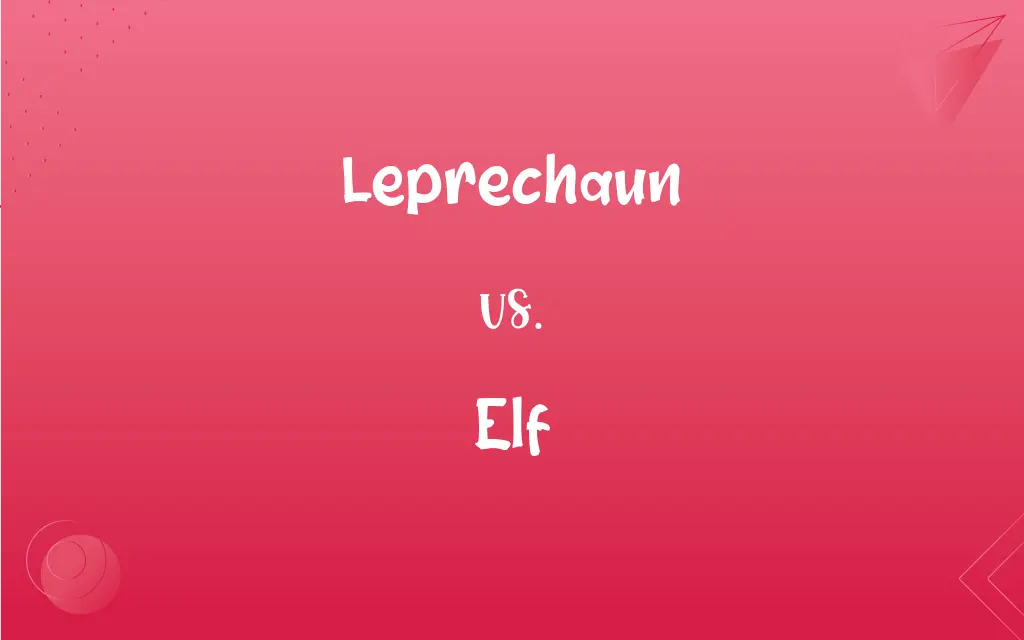Leprechaun vs. Elf: What's the Difference?
Edited by Janet White || By Harlon Moss || Updated on November 10, 2023
A leprechaun is a mischievous Irish fairy, often depicted as a small, bearded man, while an elf is a mythical creature from various folklore, known for magic, pointed ears, and a connection to nature.

Key Differences
Leprechauns, originating from Irish folklore, are often portrayed as solitary creatures who are cobblers and have a hidden pot of gold. Elves, on the other hand, appear in various cultures' mythologies, including Norse and Germanic, and are usually depicted as youthful, magical beings living in forests or other natural settings.
The leprechaun is traditionally male, wearing a coat and hat, known for their mischief and trickery, especially when guarding their treasures. Elves, conversely, are depicted in a wider range of genders and are often associated with more benevolent qualities, such as guardianship of nature, and in some stories, they help humans.
In popular culture, leprechauns are often associated with St. Patrick's Day and are symbols of Ireland, characterized by their cunning and elusive nature. Elves have a broader representation, ranging from Santa's helpers in Christmas lore to elegant, immortal beings in fantasy literature and media.
The concept of leprechauns has a more localized cultural significance, deeply rooted in Irish tradition. Elves, however, have been adapted and reimagined in various forms across different cultures, reflecting a wide range of characteristics from benevolent to mischievous.
Leprechauns are often seen as loners, whereas elves are frequently depicted as part of a community or society, highlighting the contrasting social dynamics of these mythical beings in folklore and modern representations.
ADVERTISEMENT
Comparison Chart
Origin
Irish folklore
Various mythologies (e.g., Norse, Germanic)
Appearance
Small, bearded men, often cobblers
Diverse, typically with pointed ears, youthful
Nature
Mischievous, solitary, treasure guardians
Range from benevolent nature guardians to helpers
Cultural Role
Symbol of Ireland, St. Patrick's Day icons
Broad cultural presence, from folklore to modern fantasy
Social Dynamics
Often depicted as loners
Frequently part of a community or society
ADVERTISEMENT
Leprechaun and Elf Definitions
Leprechaun
A trickster figure in stories, guarding hidden treasures.
The leprechaun cleverly evaded those seeking his pot of gold.
Elf
A helper of Santa Claus in Christmas lore.
The elf busily prepared toys in Santa's workshop for Christmas Eve.
Leprechaun
A small, mischievous fairy in Irish folklore.
The leprechaun hid his gold at the end of the rainbow.
Elf
An immortal, elegant being in modern fantasy settings.
The elf spoke of ancient times, her words filled with wisdom from centuries past.
Leprechaun
A diminutive being with a distinct appearance, including a beard and hat.
In the story, the leprechaun wore a green coat and hat.
Elf
A supernatural being in mythology, possessing magical powers.
The elf used its magic to heal the wounded animal.
Leprechaun
A symbol of Ireland, often associated with St. Patrick's Day.
Leprechauns are often seen in decorations during St. Patrick's Day festivities.
Elf
A creature with pointed ears, often depicted in fantasy literature.
The elf, with sharp ears and keen eyes, spotted the danger from afar.
Leprechaun
A solitary creature known for making shoes.
In the tale, the leprechaun crafted magical shoes overnight.
Elf
A guardian or inhabitant of natural, often forested, environments.
The elf watched over the forest, ensuring the balance of nature was maintained.
Leprechaun
In Irish folklore, a mischievous elflike creature or fairy who grants wishes or reveals the location of hidden treasure when captured.
Elf
A mythical creature in human form but usually smaller, often considered mischievous.
Leprechaun
(Irish folklore) One of a race of elves that can reveal hidden treasure to those who catch them.
Elf
A lively, mischievous child.
Leprechaun
A small mischevous elf or spirit in Irish folklore; it is often depicted in literature as a dwarfish bearded old man; - legend tells that if a leprechaun is captured, he will reveal the location of his hidden pot of gold.
Leprechaun
A mischievous elf in Irish folklore
FAQs
What do elves represent?
Elves represent various things in different cultures, from nature spirits to magical beings in fantasy stories.
Where do leprechauns originate?
Leprechauns originate from Irish folklore.
Do leprechauns grant wishes?
In some stories, leprechauns may grant wishes, especially if caught, but this is not a universal trait.
What is a leprechaun?
A leprechaun is a type of fairy in Irish folklore, typically depicted as a small, bearded man who is a shoemaker and guards a treasure.
Do leprechauns have magical powers?
Leprechauns are often attributed with certain magical abilities, particularly in evading capture.
Can elves be evil?
In some folklore and stories, elves can have malevolent or mischievous traits.
What do elves do in Santa's workshop?
In Christmas lore, elves help Santa Claus by making toys and preparing for Christmas.
Are elves real?
Elves are mythical beings and not considered real in the modern understanding of the world.
Are there female elves?
Yes, elves are depicted in both male and female forms in various stories and mythologies.
What do leprechauns wear?
Leprechauns are often depicted wearing a green coat and hat.
What is the leprechaun's pot of gold?
The pot of gold is a legendary treasure that leprechauns are said to hide at the end of a rainbow.
Do elves have special abilities?
In various mythologies and stories, elves are often attributed with magical abilities or heightened senses.
Is there a special day associated with leprechauns?
Leprechauns are particularly associated with St. Patrick's Day.
Are elves part of nature conservation in folklore?
In many stories, elves are depicted as protectors of nature and natural environments.
Is the leprechaun a symbol of luck?
Yes, leprechauns are often considered symbols of luck and fortune.
Are leprechauns always depicted as male?
Traditionally, yes, but modern interpretations sometimes include female leprechauns.
Do elves live forever?
In many fantasy stories, elves are depicted as immortal or having exceptionally long lifespans.
What is the typical habitat of an elf?
Elves are often associated with natural environments, especially forests.
How are elves depicted in "The Lord of the Rings"?
In "The Lord of the Rings," elves are depicted as ancient, wise, and elegant beings with a close connection to nature.
Can leprechauns be found in places other than Ireland?
While rooted in Irish folklore, leprechauns have been incorporated into stories and media worldwide.
About Author
Written by
Harlon MossHarlon is a seasoned quality moderator and accomplished content writer for Difference Wiki. An alumnus of the prestigious University of California, he earned his degree in Computer Science. Leveraging his academic background, Harlon brings a meticulous and informed perspective to his work, ensuring content accuracy and excellence.
Edited by
Janet WhiteJanet White has been an esteemed writer and blogger for Difference Wiki. Holding a Master's degree in Science and Medical Journalism from the prestigious Boston University, she has consistently demonstrated her expertise and passion for her field. When she's not immersed in her work, Janet relishes her time exercising, delving into a good book, and cherishing moments with friends and family.































































